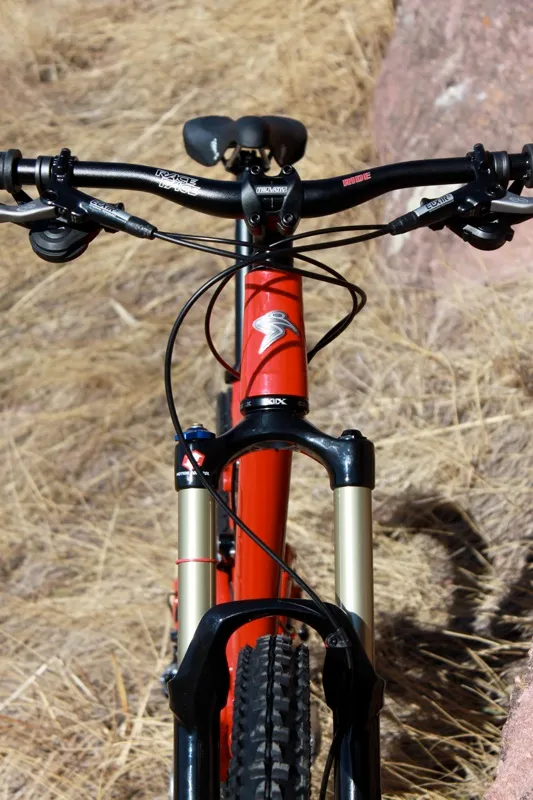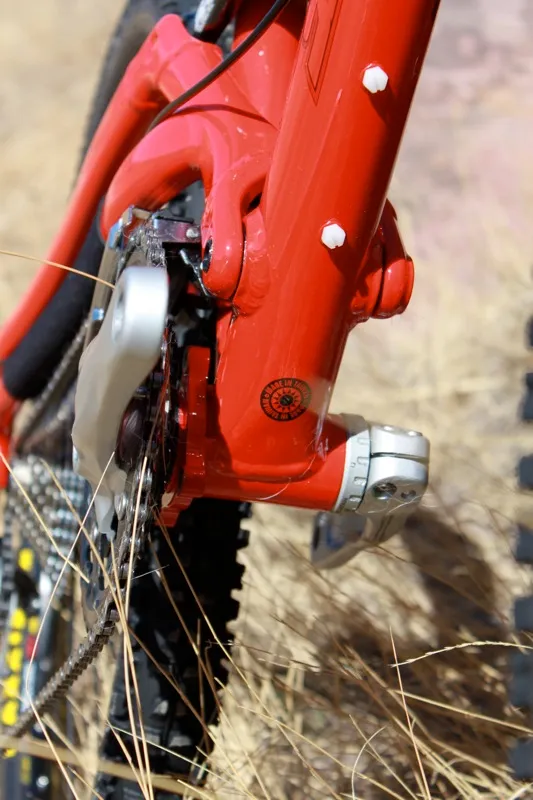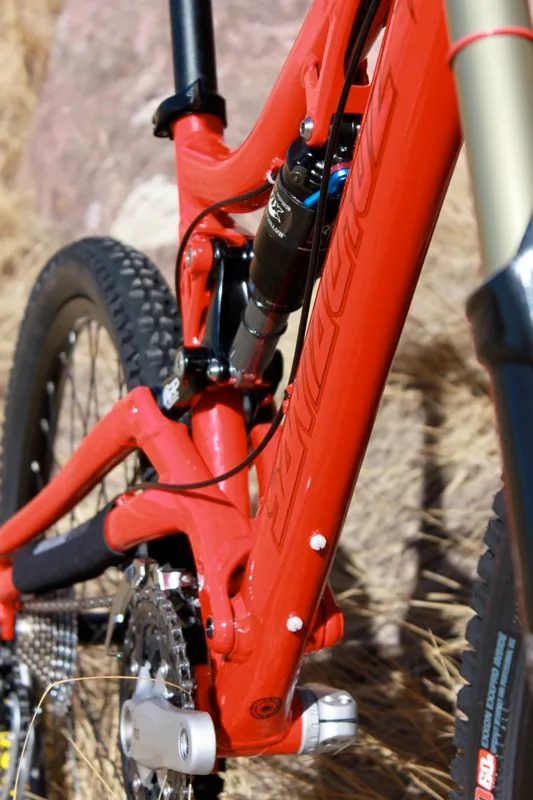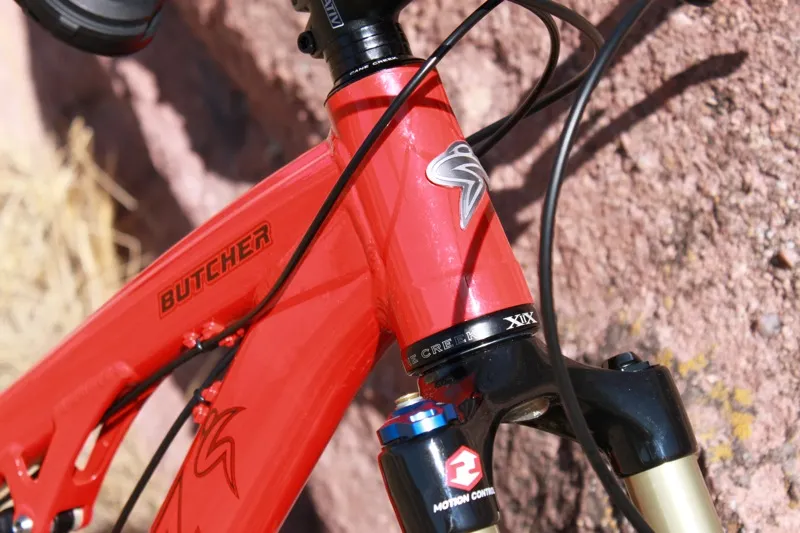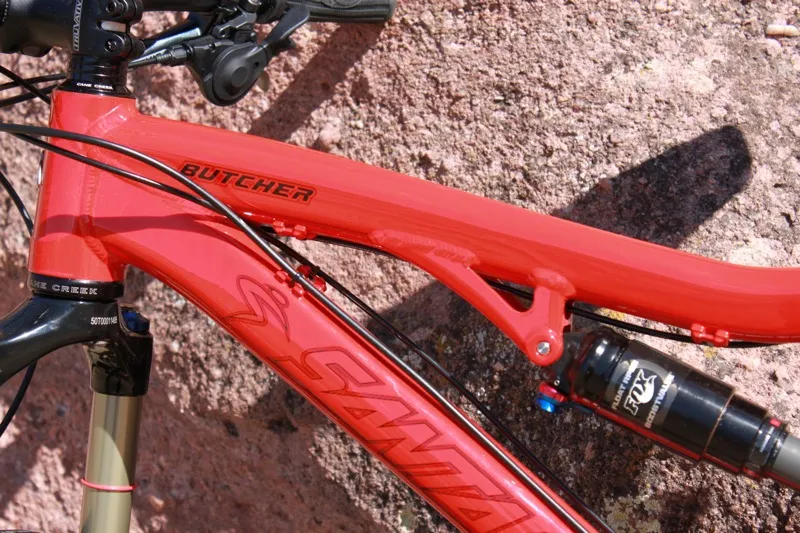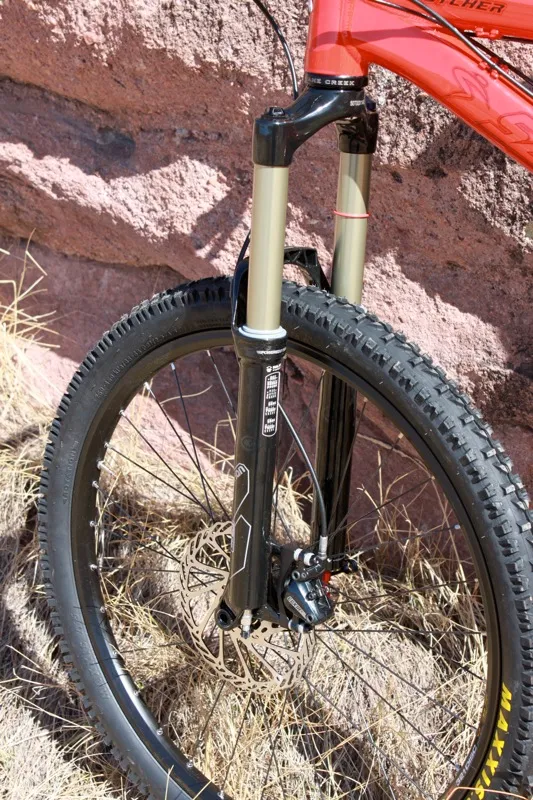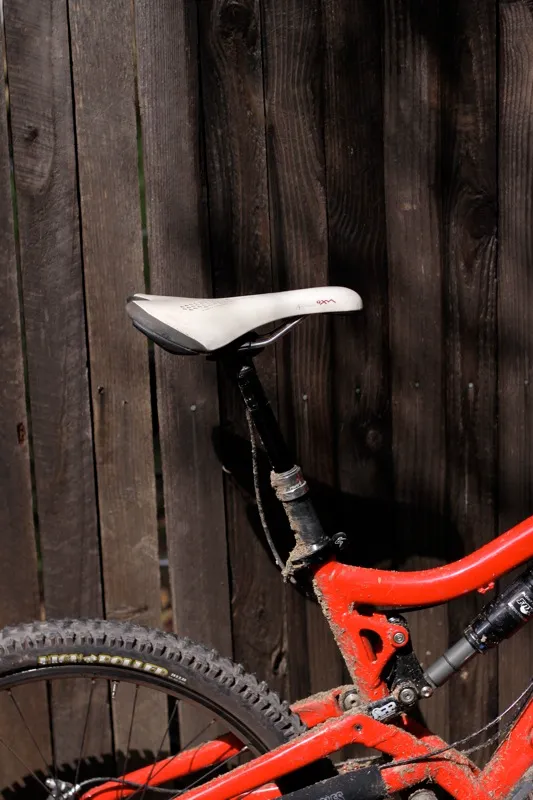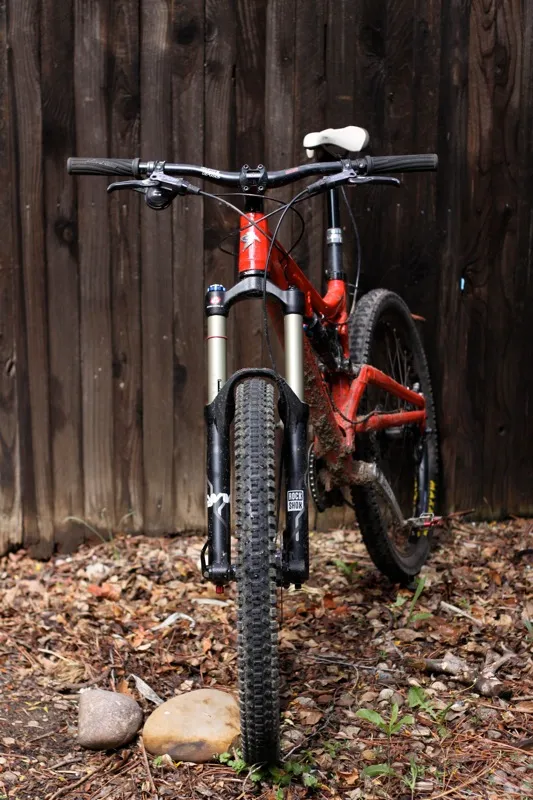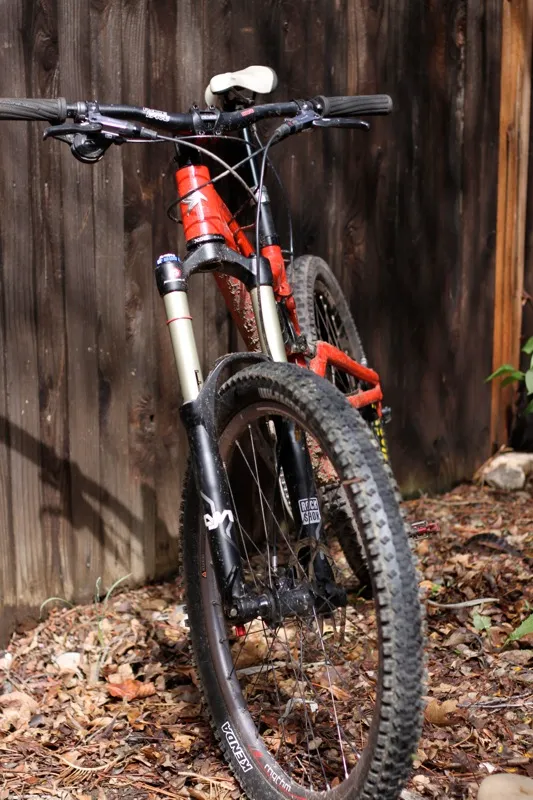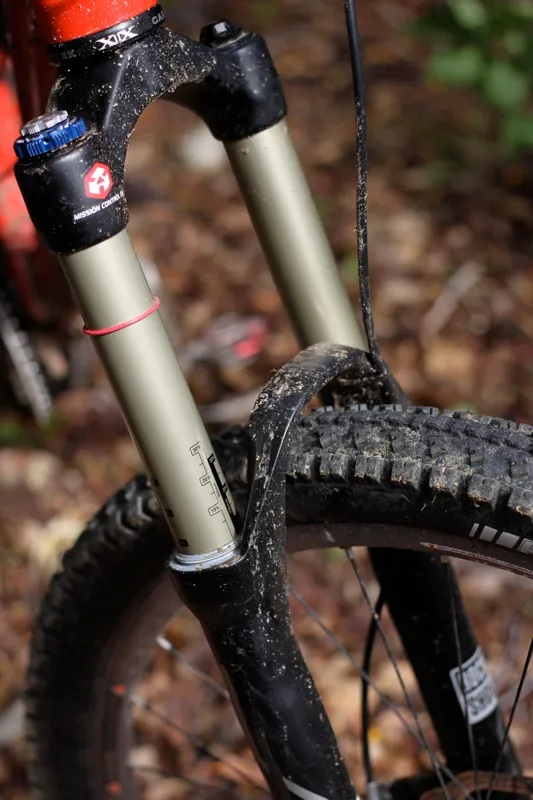After spending a solid four months on Santa Cruz’s latest trail bike, we have no doubt that the Butcher will continue the legacy of Santa Cruz’s single-pivot bikes — workhorse performers that last forever. This 150mm-travel rig isn’t light, but it's a seriously durable all-rounder, with pretty darn good suspension performance — a perfect combo for any aggressive trail rider.
Ride & handling: Confident descender and surprisingly good climber, but watch the sizing
If you want a solid 6in-travel bike and you’re looking at Santa Cruz’s Butcher, the first question you should ask is: what will I do with the bike? If the answer is super-techy all-mountain riding with lots of jumps and drops, go with your normal size. If you're looking for a trail bike to ride all day — something the Butcher is absolutely capable of — you’ll likely want to size up, as top tube lengths run quite short (22.5in for the medium, 23.5in for the large).
Despite being a short bike, that’s not super-light, we came away impressed with the ride characteristics of the Butcher. Believe it or not, this bike climbs really well. For one, the shock rate curve provided by the linkage-activated single-pivot rear end mirrors that of Santa Cruz’s pricier VPP bikes – slightly falling off the top, providing a plush feel and ample ‘negative travel’, with a flatter mid-stroke and slight ramp up at the end for bottom-out resistance.
Paired with the high main pivot location — which means the suspension reacts to pedaling inputs, especially in the little ring — this slight softness off the top makes the rear wheel dig in when climbing, resulting in excellent traction. Combined with the ProPedal platform on the Fox Float RP23 (which is a US$115 upgrade, see equipment section) shock, this gives the Butcher's suspension better climbing characteristics than a World Cup cross-country bike we were testing concurrently. The Santa Cruz was slower up hills though, due to its 30lb-plus weight.

Our test model came with a Fox Float RP23 shock upgrade; the Float R comes standard
When the trail turns down, the Butcher performs almost as well — it's definitely among the best single-pivots we’ve ridden. We did, however, take to riding it with the RP23’s ProPedal turned on in the ‘1’ position (the lowest level of low-speed compression damping), due to some mid-stroke wallow. When riding with the shock ‘open’ we found there wasn’t much to push off in the mid-stroke.
This meant we were left wanting, especially in hard cornering at moderate to fast speeds. This trait makes the chassis ripe for Fox’s new 2012 Adaptive Logic technology, where the rider can choose between a climbing platform similar to the 2011 shock's level '3' and an ‘open’ setting that can range between the current '0', '1' or '2' levels of compression damping.
At the end of the stroke, we were hard pressed to get any sort of harsh bottom-out, even when hitting 4-5ft drops while running moderate air pressure (30 percent sag) and ‘ringing the bell’, as evidenced by our travel O-ring being pushed to the very end of the shock shaft.
Frame: Stiff from the front to all the way back... well, almost all the way
Frame stiffness is really good from the front and through the pivot and elevated chainstays until you get to the very ends of the dropouts. The beefy tapered head tube doesn’t noticeably flex and offers a good foundation for larger all-mountain forks like RockShox’s Lyrik or Fox's 36.
While we agree with Santa Cruz that bikes like the new Blur TRc are better suited to the convenience of open dropouts, we feel that the Butcher would benefit from a through-axle to improve rear end stiffness. We detected some flex, in the form of a wag-like feeling under hard cornering, which we put down to the proximity and narrow stance of the chain- and seatstays.
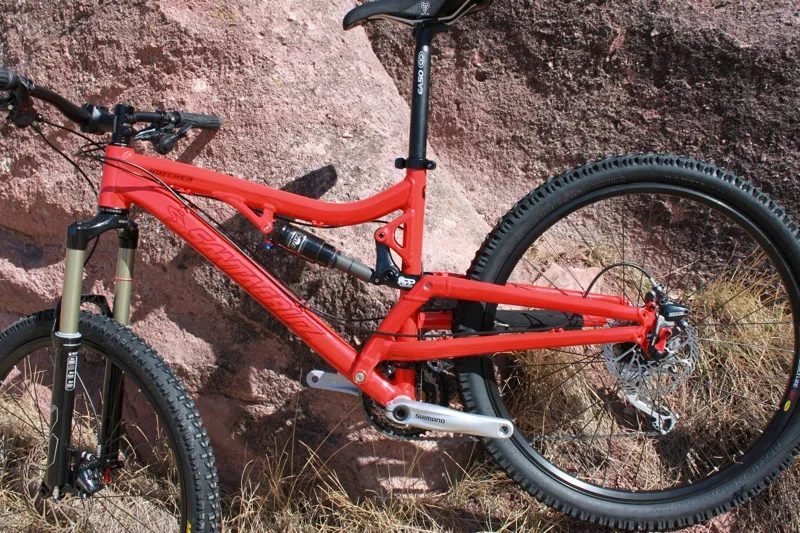
The way the stays taper to the rear dropout makes the Butcher a good candidate for a rear through-axle – it could use the additional stiffness
The geometry is pretty slack, depending on fork length, making it a stable bike when things get steep. We tried the Butcher with RockShox’s 150mm Revelation, which produces a 67.5-degree head angle, and 170mm Lyrik, which kicks it out to 66.4 degrees. We actually preferred the longer travel and slacker angle, despite the fact it made things relatively vague on climbs. The Butcher is a prime candidate for a 160 to 170mm travel-adjust fork, should you want to ride it both up- and downhill aggressively.
Despite our criticisms – of unsupported mid-stroke shock performance and slight tail wag – we were pretty darn happy whenever we threw a leg over our Butcher test bike. We rode it, progressed as riders on it and generally put it back in the garage with big smiles on our faces.
Equipment: We were balling on a budget, but the chassis serves many makers
Riders can give the Butcher its own character. Set it up with a light air shock and 10-speed drivetrain for all-day trail riding, or go the route of wide bars, chain guide (the frame has ISCG 05 tabs) and coil-sprung suspension to create a mini gravity rig. Our test bike came with Santa Cruz’s 'R am' kit and a RockShox Revelation RL fork for $2,599. We added an upgraded RP23 shock, upping the price to $2,714.
This economical package builds a very capable bike that will serve any seasoned mountain biker well, yet won't make you cringe too badly when you throw it down in a rock garden. The 'R am' kit combines Shimano’s 10-speed SLX shifters with XT derailleurs and a non-series 552 (Deore-level, 10-speed) three-ring crankset. Avid Elixir R brakes with 160mm rear and 185mm front rotors handle the braking duties.
The cockpit is a mix of Truvativ (AKA stem), Race Face (Ride handlebar, which at 680mm wide was too narrow for a bike with all-mountain ambitions) and Easton (EA50 seatpost) kit. Wheels combine Shimano hubs with Mavic XM321 rims and are shod with Maxxis HighRoller 2.35 single-ply wire-bead rubber. The bike is missing one key component, however: a dropper seatpost. Riding without one severely limits its capabilities.
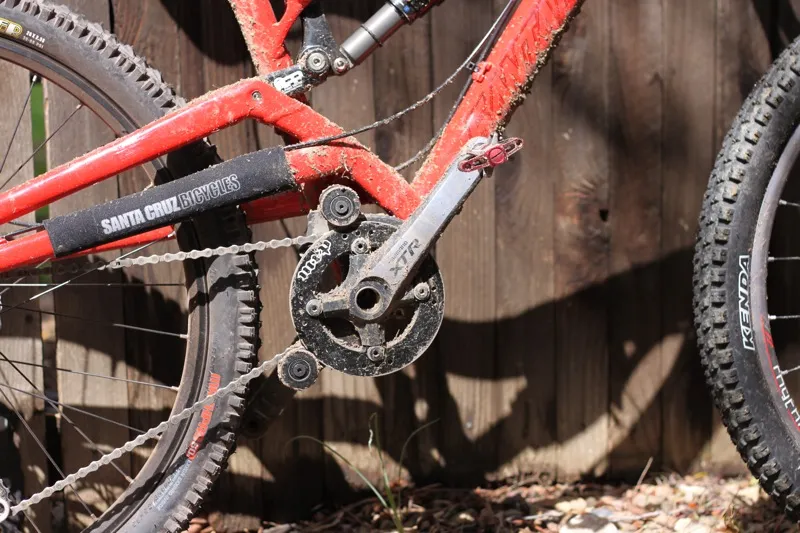
We added a chainguide to offset the design's propensity to throw the chain
We also found that the Butcher begs some sort of chain management. The elevated chainstay design offers no help keeping the chain on the rings; a standard stay at least limits how far a chain can swing and does sometimes keep it from bouncing off. We were constantly bouncing the chain off the big ring and after a month we switched to an MRP chainguide. The bike's just a bit too heavy for most riders to get away with a single ring, so we'd recommend something like an MRP LRP shift guide or e*thirteen DRS.
At the very end of our test we swapped out the Revelation RL suspension fork for a 170mm-travel Lyrik RC2 DH after riding the lighter trail fork to its limit — we had a couple of bottom-outs on drops that made the fork flex and front end feel like it was squirting away from us. The Lyrik changed the bike drastically, giving it serious stability and making it a much safer tool in our sometimes sketchy hands. Tacking a Monarch Plus or Fox DHX Air rear shock onto the chassis would add yet another level of performance to this workhorse, again confirming that Butcher is a bike for many riders.


